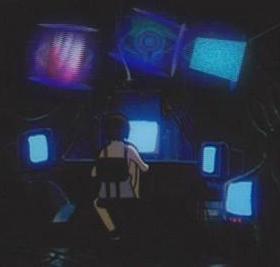
Lain Iwakura in “Serial Experiments Lain”.
Overview[]
“Classic cyberpunk characters were marginalized, alienated loners who lived on the edge of society in generally dystopic futures where daily life was impacted by rapid technological change, an ubiquitous datasphere of computerized information, and invasive modification of the human body.” – Lawrence Person, Nova Express issue 16, 1998
Cyberpunk Works[]
- Akira
- Blade Runner
- Ghost in the Shell
- Serial Experiments Lain (source of the page image)
- The Matrix
- Tom Clancy's Splinter Cell
Cyberpunk Derivatives[]
Steampunk[]
Steampunk, based on an era (1837-1919 or later to 1930s) centered on the Victorian Era and Edwardian Era, is one of the most notable developments of the cyberpunk concept. The genre initially combined extrapolations of Victorian technologies and styles with cyberpunk's bleak film noir world view. It has since developed in a less dystopian direction.
- Avatar: The Last Airbender and it's spinoff sequel Legend of Korra (the first series got limited elements alongside with far eastern looked Clockpunk but the second series is full-blown, however)
Dieselpunk[]
Dieselpunk is a subgenre blending the aesthetics of the 1920s through the early 1950s with today. Dieselpunk is based on the aesthetics of the interbellum period through World War II (c. 1920-1945). The genre combines pop surrealist art with postmodern technology and sensibilities. First coined in 2001 as a marketing term by game designer Lewis Pollak to describe his role-playing game Children of the Sun, dieselpunk has grown to describe a distinct style of visual art, music, motion pictures, fiction, and engineering.
Dieselpunk works[]
- Sky Captain and the World of Tomorrow
- War of the Worlds: Goliath
- Legend of Korra (The genre take overtime in rest of "Books")
Biopunk[]
Biopunk[1][2] emerged during the 1990s and describes the underground of the biotechnological revolution which was expected to start having a profound impact on humanity in the first half of the 21st century. Biopunk fiction typically describes the struggles of individuals or groups, often the product of human experimentation, against a backdrop of totalitarian governments or megacorporations which misuse biotechnologies as means of social control or profiteering. Unlike cyberpunk, it builds not on information technology but on synthetic biology and may crosses few times with Sci-Fantasy. As in postcyberpunk, however, individuals are usually modified and enhanced not with cyberware, but by genetic manipulation of their chromosomes and other ways to manipulated the body in general.
Biopunk works[]
- BioShock
- Dark Angel (also containing cyberpunk influences)
- Gattaca
- Repo! The Genetic Opera (besides movie is mostly biopunk, but adds few more elements with gothicpunk and cyberpunk)
- Orphan Black
- Resident Evil
Atompunk[]
Atompunk relates to the pre-digital period of 1945-1965, including mid-century Modernism, the Atomic Age and Space Age, Communism and concern about it exaggerated as paranoia in the USA along with Neo-Soviet styling, underground cinema, Retro-futurism, Googie architecture, the Sputnik program, superhero fiction, the rise of the US military/industrial powers and the fall-out of Chernobyl. Its aesthetic tends toward Populuxe and Raygun Gothic, which describe a retro-futuristic vision of the world. Among the most notable examples is the Fallout video game series.
